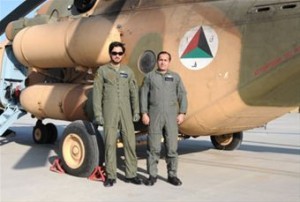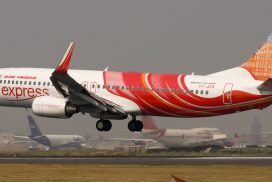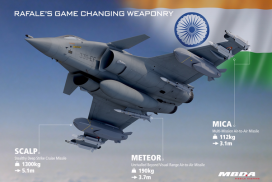 The first two Afghan air force helicopter pilots have completed basic pilot training in the United States. The recently begun Mi-17 qualification course meant to convert them into Mi-17 helicopter pilots at the Afghan air force base in Kabul. A hybrid of Croatian and U.S. helicopter training syllabus, this course is a six-month evolution that will qualify the pilots, 1st Lt. Abdul Saboor Amin and 1st Lt. Ahmad Fawad Haidari, as helicopter commanders in the Mi-17 and authorize them to fly as such in the Afghan air force, said U.S. Navy Lt. Jason Dickerson, the NATO Air Training Command-Afghanistan/438th Air Expeditionary Advisory Squadron training & evaluations officer. “Since they have been trained and winged via a U.S. training program, the expectations from them as far as skill-level and overall professionalism is very high,” Lieutenant Dickerson said.
The first two Afghan air force helicopter pilots have completed basic pilot training in the United States. The recently begun Mi-17 qualification course meant to convert them into Mi-17 helicopter pilots at the Afghan air force base in Kabul. A hybrid of Croatian and U.S. helicopter training syllabus, this course is a six-month evolution that will qualify the pilots, 1st Lt. Abdul Saboor Amin and 1st Lt. Ahmad Fawad Haidari, as helicopter commanders in the Mi-17 and authorize them to fly as such in the Afghan air force, said U.S. Navy Lt. Jason Dickerson, the NATO Air Training Command-Afghanistan/438th Air Expeditionary Advisory Squadron training & evaluations officer. “Since they have been trained and winged via a U.S. training program, the expectations from them as far as skill-level and overall professionalism is very high,” Lieutenant Dickerson said.
Both the Croatian and U.S training pipelines are extremely challenging, and by design, the pilots expect a very high amount of work and professionalism to ensure a quality product, Lieutenant Dickerson said. As such, these two pilots are being held to a much higher standard. Such an attention to detail is evident during a flight brief for a training mission that Lieutenants Amin and Haidari flew with their instructor pilot, Croatian air force Capt. Zoran Maranovic, an adviser with the 438th AEAS. Perusing through the pre-flight weather, fuel, cargo and mission information, Captain Maranovic quizzed the Afghan pilots’ understanding of the Mi-17 and the day’s mission: a trip to Blackwater, a training site outside of Kabul, to practice traffic patterns. “You put a pilot into traffic patterns you will learn everything you need to know about the pilot,” Captain Maranovic said.
“Traffic patterns involve many elements of piloting: take-off, flying, ascent, descent, hovering, and final approach,” he said. “It is a way of building consistency in skills and ability. This exercise gives them experience regarding how the aircraft operates, and is the best exercise for forming the foundation of pilot training.” Successfully answering Captain Maranovic’s questions, Lieutenant Amin, Lieutenant Haidari and their IP made their way to the aircraft to begin the training evolution, which will bring their total flight time to around nine hours in the Mi-17. “They are getting better and better,” Captain Maranovic said. “They are exactly where they should be.” Switching focus from the training mission to the future of the pilots and the Afghan air force, Captain Maranovic said, “They are good pilots, and we will see a big difference in the Afghan Air Force because of them. If NATC-A continues to advise and instruct the pilots, we will not only lift the skill found in the Afghan air force, but we will also lift their spirits. Attitudes also need advising.”
“We hope to finish this training and learn from the IPs so we can be the ones training future (Afghan air force) pilots,” Lieutenant Amin said. “We are trying to bring a change in professionalism and safety to the pilot corps,” he said. It is this devotion to duty and Afghanistan that raises hope and admiration in NATC-A advisers and Airmen throughout the Afghan air force, Lieutenant Dickerson said. “Lieutenants (Amin) and (Haidari) continue to impress all of the coalition advisers as well as their fellow Afghans,” he said. “They are fitting in well with the existing squadron and are already very well respected among many of the current Afghan military (members).”



